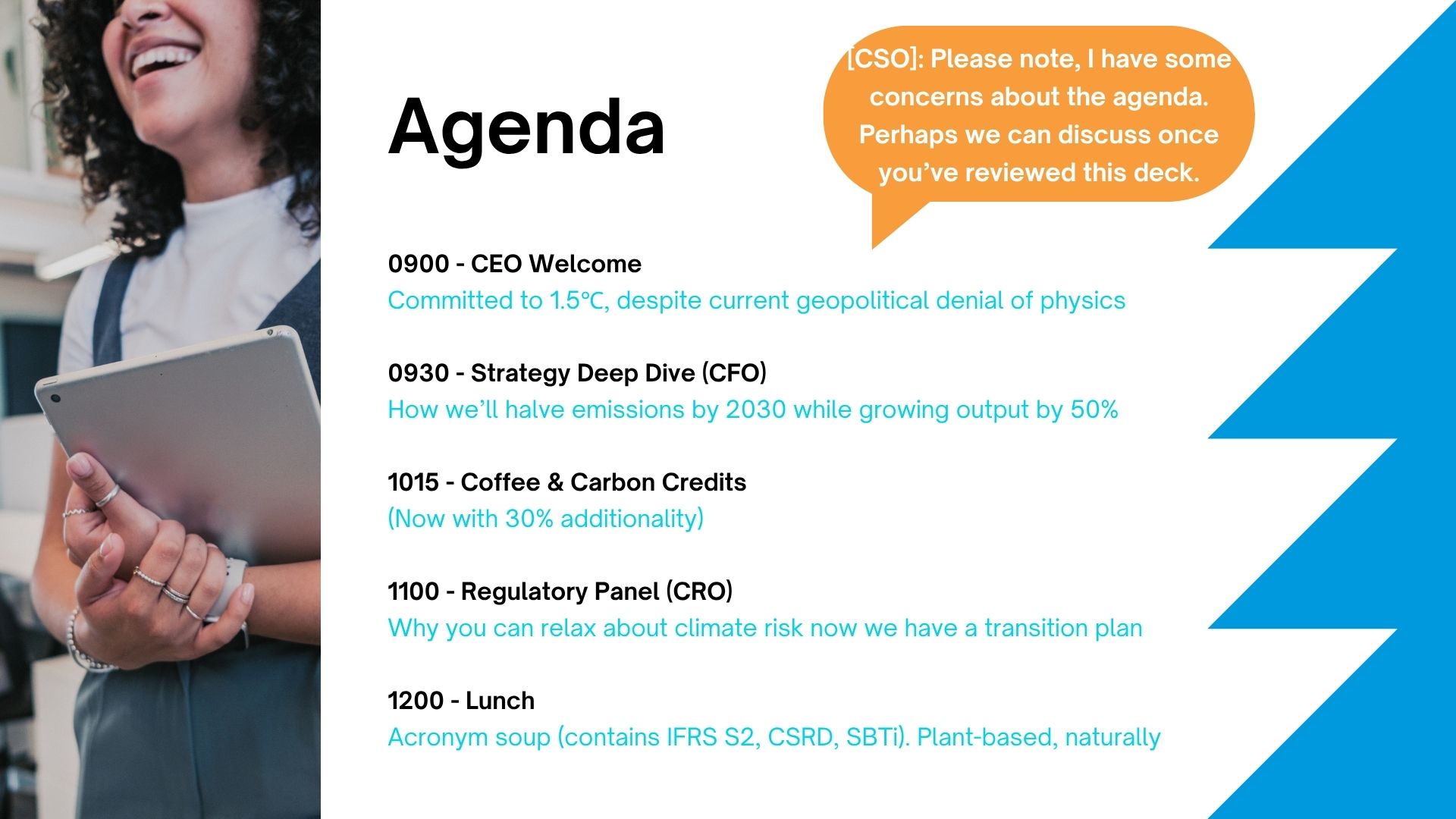
Build to matter
Ready to work together?
If you’re ambitious about growing a business that matters—and resonate with our approach—we’d be delighted to talk.
Climate transition plans face a paradox: ambitious 1.5°C targets meet messy reality. How companies navigate Scope 3, net zero by 2050, and the integrity gap.
Andrew Hutchison
October 16, 2025

Setting the scene:
The CFO checks the mic. The Chief SustainabilityOfficer rehearses her “science-based targets” slide. Investor Relations quietly wishes Scope 3 didn’t exist. Welcome to the newest addition to the corporate calendar: The Climate Capital Markets Day.
This might not be fiction for long. As regulators,investors, and lenders turn up the heat, transition plans are becoming the new currency of corporate credibility – expected to be as detailed, auditable, and forward-looking as a financial forecast.
The difference? This forecast extends to 2050,depends on global policy shifts, and includes one-size-fits-all targets the company cannot fully control.
09:00 – CEO Welcome: “We remainfully committed to a 1.5°C pathway, even though some world leaders arecurrently convinced you can negotiate with the laws of physics.”
09:30 – Strategy Deep Dive: How we’ll halve emissions by 2030 while growing output 50%
10:15 – Coffee & Carbon Offsets: Now with 30% additionality
11:00 – Regulatory Panel: Why you can relax about climate risk now we’ve got a transition plan
12:00 – Lunch: Acronym soup (contains IFRS S2, CSRD, SBTi). Plant-based,naturally

On paper, it sounds simple: set near-term targets aligned to a 1.5°C pathway, typically a 45–50% reduction in absolute emissionsby 2030, reaching net zero by 2050. The better your climate literacy, the more you realise just how hard this is.
In practice, most companies discover that the vast majority of their emissions sit in Scope 3 – buried deep in supply chains, customer use, and the wider economy. These are emissions they can influence, but not control.
Yet, under science-based frameworks, all must declare they’re (more or less) halving emissions – regardless of business model and maturity or whether the world’s policy and infrastructure can actually support it.
It’s the equivalent of announcing a 30% by 2030 global EBITDA margin target because an international accounting standard said that’s how we combat economic stagnation.
You know your business model and industry economics make that impossible, but you also know that saying so could put you out ofline with prevailing guidance, peers and may send the wrong signals to investors.
So, you smile, show the slide, and promise to “leverage partnerships across the value chain.”

Here’s the uncomfortable truth: 1.5°C is slipping out of reach.
Global emissions hit another record high last year. Based on current policies,we’re on track for roughly 2.7°C[2] of warming by the end of the century.
Everyone in the room knows it.
No one wants to say it out loud.
Because acknowledging it risks being read as defeatist yet ignoring it feels delusional. And the political environment isn't helping. Four-year election cycles dictate actions with decades-long consequences. Companies are navigating thirty-year decarbonisation pathways while governments flip between climate ambition and fossil fuel revival.
Boards demand compliance and to stave off liability
Regulators demand assurance to stave off compounding, systemic risk
Investors demand credibility to stave off surprises
So, the corporate climate plan becomes a study in restraint: balancing truth and hope, data and narrative, realism and resolve.
And yet, striving for 1.5°C (even if it’s aspirational) still matters deeply. Every tenth of a degree avoided saves lives, livelihoods, and ecosystems. It’s a moral direction, not just a metric.
As the last Q&A wraps up and the lights dim,everyone sits in stunned silence. What started a few years ago with wild brand promises around racing to zero has become the stage on which a company’s strategy, risk management and credibility converge.
Three lessons stand out:
.jpg)
The increasing wave of climate regulation,disclosure standards and investor scrutiny is, at its core, a positive force. It’s slowly driving transparency, accountability and capital allocation towards genuine transition.
But as standards proliferate, streamline and normalise, and political winds shift, we must stay pragmatic and grounded inreality, so that progress remains tangible, not theoretical – or theatrical!
Ambition without realism risks paralysis; realism without ambition risks complacency. The sweet spot is progress – measurable, imperfect, and moving in the right direction.
Whilst the above is clearly light-hearted, we need more of these open and pragmatic conversations between real economy actors, investors and policymakers.
TL:DR: Transition plans are fast becoming a hallmark of corporate credibility, yet most still hang their hook on targets the world isn’t equipped to meet. This piece explores the tension between ambition and realism in climate strategy – why honesty about dependencies, uncertainty, and limits builds more trust than slogans ever could. The call: own your pathway, stay transparent, and keep striving toward 1.5°C even as it slips further from reach.
[1] InternationalEnergy Agency (IEA), January 2025.
[2] Climate Action Tracker,November 2024.